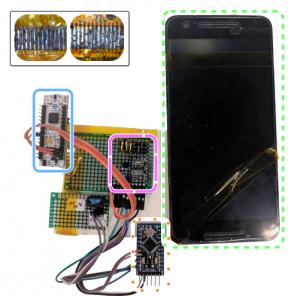Researchers demonstrate new firewall that protects cellphones from security threat

Cellphone parts harboring malicious code can be surreptitiously placed in various replaceable phone components, compromising user data and security. Ben-Gurion University of the Negev researchers areThe researchers are seeking to further test the patent-pending technology with phone manufacturers. Credit: Ben-Gurion U.
Earlier this year, Dr. Yossi Oren and his team of researchers in the BGU Department of Software and Information Systems Engineering (ISE), discovered a security vulnerability in the internal communications between Android cellphone components and a phone's central processing unit (CPU). They alerted Android developer Google and helped the global company address the problem.
“Our technology doesn't require device manufacturers to understand or modify any new code,” says Dr. Oren. “It's a firewall that can be implemented as a tiny chip, or as an independent software module running on the CPU.”
Some 400 million people change their phone's components, such as touchscreens, chargers, and battery or sensor assemblies, which are all susceptible to significant security breaches and attacks. These components, referred to as “field replaceable units (FRUs),” communicate with the phone CPU over simple interfaces with no authentication mechanisms or error detection capabilities.
A malicious vendor could add a compromised FRU to a phone, leaving it vulnerable to password and financial theft, fraud, malicious photo or video distribution, and unauthorized app downloads.
“This problem is especially acute in the Android market with many manufacturers that operate independently,” the researchers say. “An attack of this type occurs outside the phone's storage area; it can survive phone factory resets, remote wipes and firmware updates. Existing security solutions cannot prevent this specific security issue.”
Researcher Omer Schwartz adds, “There is no way for the phone itself to discover that it's under this type of an attack. Our solution prevents a malicious or misconfigured FRU from compromising the code running on the CPU by checking all the incoming and outgoing communication.”
The research team used machine learning algorithms to monitor the phones' internal communications for anomalies that may indicate malicious code. Their software allowed them to identify and prevent hardware-generated data leaks and hacks.
A paper on the discovery and the new software will be presented at the prestigious Workshop on Offensive Technologies in Vancouver, Canada this August. Dr. Oren and Dr. Asaf Shabtai collaborated on the paper along with research students Omer Shwartz and Amir Cohen.
“The work of Dr. Oren's team is the latest invention from ISE at BGU,” says Zafrir Levi, senior vice president of business development at BGN Technologies, the University's commercialization and technology transfer company. “In the last decade, ISE has spawned many inventions that have been used worldwide through patents sold to international corporations and by start-up companies.”
The researchers are seeking to further test the patent-pending technology with phone manufacturers.
###
About American Associates, Ben-Gurion University of the Negev
American Associates, Ben-Gurion University of the Negev (AABGU) plays a vital role in sustaining David Ben-Gurion's vision: creating a world-class institution of education and research in the Israeli desert, nurturing the Negev community and sharing the University's expertise locally and around the globe. As Ben-Gurion University of the Negev (BGU) looks ahead to turning 50 in 2020, AABGU imagines a future that goes beyond the walls of academia. It is a future where BGU invents a new world and inspires a vision for a stronger Israel and its next generation of leaders. Together with supporters, AABGU will help the University foster excellence in teaching, research and outreach to the communities of the Negev for the next 50 years and beyond. Visit vision.aabgu.org to learn more.
AABGU, headquartered in Manhattan, has nine regional offices throughout the United States. For more information, visit http://www.
Media Contact
All latest news from the category: Information Technology
Here you can find a summary of innovations in the fields of information and data processing and up-to-date developments on IT equipment and hardware.
This area covers topics such as IT services, IT architectures, IT management and telecommunications.
Newest articles

A ‘language’ for ML models to predict nanopore properties
A large number of 2D materials like graphene can have nanopores – small holes formed by missing atoms through which foreign substances can pass. The properties of these nanopores dictate many…

Clinically validated, wearable ultrasound patch
… for continuous blood pressure monitoring. A team of researchers at the University of California San Diego has developed a new and improved wearable ultrasound patch for continuous and noninvasive…

A new puzzle piece for string theory research
Dr. Ksenia Fedosova from the Cluster of Excellence Mathematics Münster, along with an international research team, has proven a conjecture in string theory that physicists had proposed regarding certain equations….



